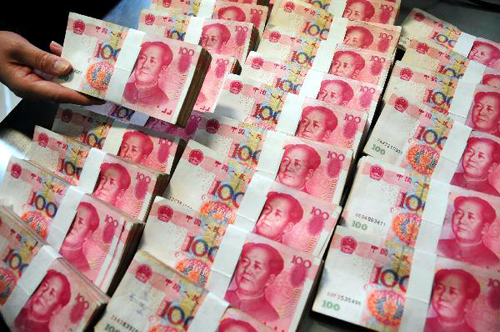New trends in China's banking industry
- By Ba Shusong
 0 Comment(s)
0 Comment(s) Print
Print E-mail China.org.cn, May 30, 2017
E-mail China.org.cn, May 30, 2017
|
|
|
In 2016, the Chinese central bank launched the Macro Prudential Assessment (MPA) regime and began to assess the overall financial health of banks. [Photo/Xinhua] |
To begin with, market oversight and appraisal have become increasingly tight. In 2016, the Chinese central bank launched the Macro Prudential Assessment (MPA) regime and began to assess the overall financial health of banks.
Second, banks are under mounting pressure to change their conventional profit-making approaches. With the liberalization of interest rates, banks have had to diversify their income structure to compete. Net interest margins have narrowed. As more capital providers choose to bypass banks to invest directly with users, banks' role as intermediate has weakened. The high leverage ratio in non-financial sector has led to high non-performing loan ratios in banks. The yuan's inclusion in the SDR basket has created new growth drivers in the banking industry while imposing more requirements on banks' risk management systems. The liberalization of capital account systems and the frequent interaction with foreign capital markets have also brought challenges and opportunities to the banking industry.
Technological progress and market changes will set future trends for the banking industry with the following features.
Intelligent banks featuring advanced technologies. Unlike conventional banks, intelligent banks will rely on analysis and IT technologies. An intelligent bank's fate will be determined by the bank's technological power instead of its financial services. According to a survey of Chinese bankers, in the technological area banking based on big data has attracted the highest amount of attention.
Nimble banks featuring flexible and efficient operations. Since 2015, many banks have managed to break the link between profit growth and business size. Some have seen a drop in the proportion of risk-weighted assets. Preliminary achievements have been made in the transformation to nimble banks. Specifically speaking, nimble banks show the following features: With flexible assets and efficient profit-making approaches, they mainly engage in big asset management and big investments; through securitization, they can promote an efficient use of available assets; the size of securities issued grows continuously; And the pricing methods are being improved. The trading of securities will be key to the transformation of traditional banks trying to diversify their profit-making approaches and enhance competitiveness.
International banks featuring a global perspective. Chinese banks have been working hard to catch up with large foreign banks in global development. But their achievements differ greatly. While the five major commercial banks have enjoyed widespread business overseas, others are just getting started. Hong Kong and Southeast Asia are home to most Chinese banking outlets. Regarding the five major commercial banks, 71.4 percent of their branches were located in Asia and Europe at the end of 2015.
There are some other noteworthy trends in the Chinese banking industry.
First, market oversight will become stricter, and prudent monetary policy will be improved. In 2017, China will tighten its domestic monetary policy. The terminal interest rate in the currency market will be increased. Further efforts will be made to lower the leverage ratio in the financial sector. The Macro Prudential Assessment system will be improved and effectively implemented to check banks' lending.
Second, the emergence of credit risks and the forming of non-performing assets will slow down with more controlling measures being taken, and greater emphasis will be placed on banks' profitability. From 2016, the emergence of non-performing assets in China has slowed down, with the overall non-performing loan ratio registered at 1.74 percent. A spate of measures have been implemented to treat non-performing assets. Great achievements have been made in the securitization of corporate assets. In 2017, attention should be attached to banks' inventory replenishment, short cycle time and profitability.
Third, banks will adjust their loan structure to shift their focus to infrastructure and emerging industries. In 2017, with domestic liquidity tightened, banks will be making fewer loans. Public-Private Partnership (PPP) and industry development fund will be a way for them to participate in infrastructure investment.
Fourth, regarding banks' profitability, the net interest margin will remain generally unchanged, their business size will expand steadily and the growth rate of their profits will rebound. In 2017, due to the lowered pressure for asset revaluation, the weakened influence of the policy to replace business tax with VAT and the rise of interest rates caused by tightened liquidity, Chinese banks will see slight drops in net interest margin.
Ba Shusong is the Chief Economist for the China Banking Association and the Chief China Economist for the Hong Kong Stock Exchange.
The article was translated by Chen Xia from an unabridged version published in Chinese.
Opinion articles reflect the views of their authors only, not necessarily those of China.org.cn.







Go to Forum >>0 Comment(s)